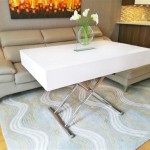What Causes A Glass Patio Table To Shatter?
Glass patio tables are a popular choice for outdoor dining and entertaining due to their aesthetic appeal and ease of cleaning. However, they are also known to unexpectedly shatter, sometimes even seemingly without any external force. Understanding the factors that contribute to this phenomenon is crucial for preventing accidents and ensuring the longevity of outdoor furniture.
The tempered glass used in patio tables is designed to be more durable than standard glass. The manufacturing process involves heating the glass to a high temperature and then rapidly cooling it. This process creates a compressive stress on the surface of the glass and tensile stress in the interior. This balance makes the glass significantly stronger and more resistant to impact. However, if this balance is disrupted or compromised in any way, the glass becomes vulnerable and can shatter.
Internal and External Flaws
One of the primary reasons for spontaneous shattering is the presence of internal flaws or imperfections within the glass. These imperfections can be microscopic cracks or inclusions, such as nickel sulfide, which are introduced during the manufacturing process. While quality control measures aim to eliminate these flaws, some inevitably slip through. Nickel sulfide inclusions are particularly problematic because they can expand and contract with temperature fluctuations, placing additional stress on the glass. Over time, this stress can weaken the glass and lead to a sudden fracture.
External flaws, such as scratches, chips, or abrasions on the surface of the glass, also weaken the structure. These surface imperfections disrupt the compressive stress layer, making the glass more susceptible to cracking and shattering. Even seemingly minor scratches can act as stress concentrators, where the applied force is amplified, leading to a catastrophic failure. Regular inspection of the glass surface for any signs of damage is crucial for early detection and potential preventative measures.
The quality of the glass itself plays a significant role. Lower quality tempered glass may contain more imperfections or be less effectively tempered, making it inherently more prone to shattering. Opting for patio tables made with high-quality glass from reputable manufacturers can significantly reduce the risk of spontaneous breakage.
Thermal Stress and Temperature Fluctuations
Temperature fluctuations can exert considerable stress on glass patio tables. When the glass heats up, it expands, and when it cools down, it contracts. If different parts of the glass heat or cool at different rates, it can create uneven stress distribution. For example, if a portion of the table is shaded while the rest is exposed to direct sunlight, the temperature differential can induce significant stress. Over time, these repeated cycles of expansion and contraction can weaken the glass and lead to shattering.
Extreme temperature changes, such as those experienced during sudden thunderstorms or heat waves, can exacerbate this problem. The greater the temperature difference, the greater the stress on the glass. Choosing a location for the patio table that minimizes direct exposure to sunlight or provides consistent shading can help mitigate the effects of thermal stress.
The color of the glass can also influence how it absorbs heat. Darker glass absorbs more heat than lighter glass, making it more susceptible to thermal stress. Consider choosing a lighter colored glass for patio tables in areas with strong sunlight.
Impact and Load Distribution
While tempered glass is designed to withstand considerable impact, it is not indestructible. A sharp impact, even one that seems relatively minor, can cause the glass to shatter, especially if it is already weakened by internal or external flaws. Dropping heavy objects on the table, or even inadvertently bumping it with a hard object, can trigger a fracture.
Uneven load distribution can also contribute to shattering. If the table is not placed on a level surface, or if heavy objects are concentrated in one area, it can create excessive stress in certain parts of the glass. Ensuring that the table is placed on a stable, level surface and that weight is evenly distributed across the tabletop can help prevent this type of failure.
The design of the table frame also plays a role in load distribution. A poorly designed frame may not adequately support the glass, leading to localized stress concentrations. Tables with robust frames that provide even support are less likely to experience shattering due to uneven load distribution.
Furthermore, the presence of hard objects placed directly on the glass surface without protection, such as ceramic pots or metal decorations, can also increase the risk of shattering. These objects can create stress points and amplify the impact of even minor bumps or vibrations.
Improper Installation and Maintenance
Incorrect installation of the glass tabletop within the frame can induce stress and contribute to shattering. If the glass is too tightly fitted into the frame, it may be subjected to undue pressure, making it more vulnerable to fracture. Similarly, if the retaining clips or fasteners are overtightened, they can create stress points on the glass surface.
Regular maintenance is also essential for preventing shattering. This includes cleaning the glass with appropriate cleaning solutions to avoid scratching or damaging the surface. Abrasive cleaners or scouring pads should be avoided, as they can create microscopic scratches that weaken the glass. Mild soap and water, or specialized glass cleaners, are the best options.
Over time, the frame of the patio table may become loose or damaged, which can compromise the support for the glass and increase the risk of shattering. Regularly inspecting the frame for signs of damage and making necessary repairs can help maintain the integrity of the table and prevent accidents.
Storing glass patio tables properly during the off-season is also important. Exposing the table to harsh weather conditions, such as extreme cold or prolonged exposure to moisture, can weaken the glass and make it more susceptible to shattering. Storing the table indoors or covering it with a protective tarp can help protect it from the elements.
The age of the glass also plays a factor. Over time, even well-maintained tempered glass can become more brittle and prone to shattering. The internal stresses within the glass may gradually weaken, making it more susceptible to external factors. While it is difficult to predict when glass will fail, it is important to be aware of this potential issue and to take extra precautions with older patio tables.
In conclusion, multiple factors, individually or in combination, can contribute to the shattering of a glass patio table. Understanding these factors and taking preventative measures can significantly reduce the risk of accidents and extend the lifespan of outdoor furniture. Regular inspection, proper maintenance, and careful placement of the table are crucial for ensuring its safety and durability.

5 Tips To Stop Your Glass Patio Table From Shattering Posh Living

Patio Table Shattered What Now

5 Tips To Stop Your Glass Patio Table From Shattering Posh Living

Mum Issues Warning After Glass Garden Table Shatters Leaving Her Patio Covered In Dangerous Shards The Sun

Argos Under Pressure To Recall Exploding Glass Tables

Asda Glass Tables Explodes As Children Sat Around It Daily Mail

Exploding Glass Recalls And Safety Alerts

5 Tips To Stop Your Glass Patio Table From Shattering Posh Living

Mum Issues Warning After Glass Garden Table Shatters Leaving Her Patio Covered In Dangerous Shards The Us Sun

Asda Glass Tables Explodes As Children Sat Around It Daily Mail
Related Posts








